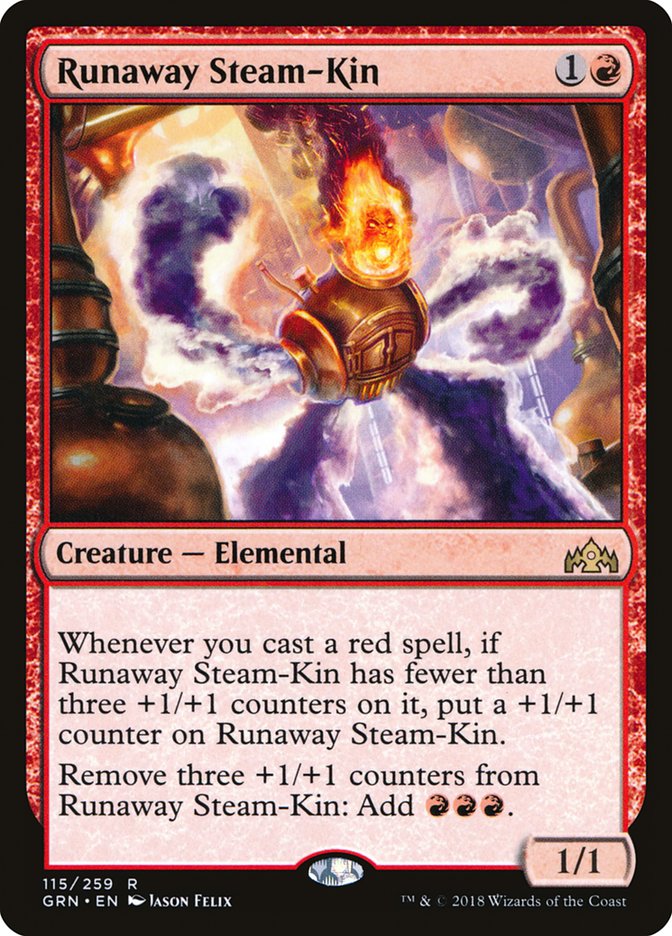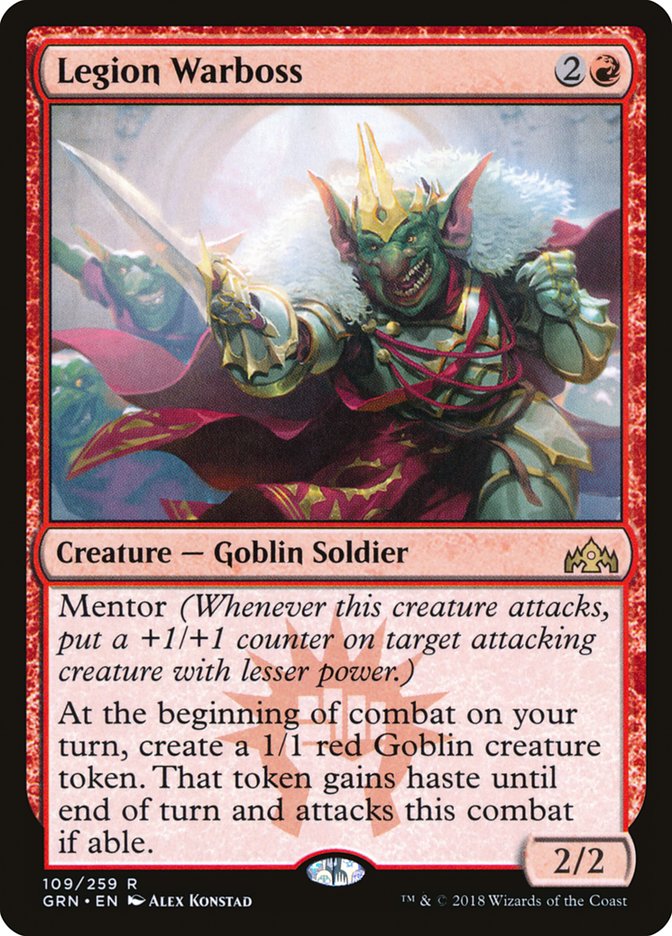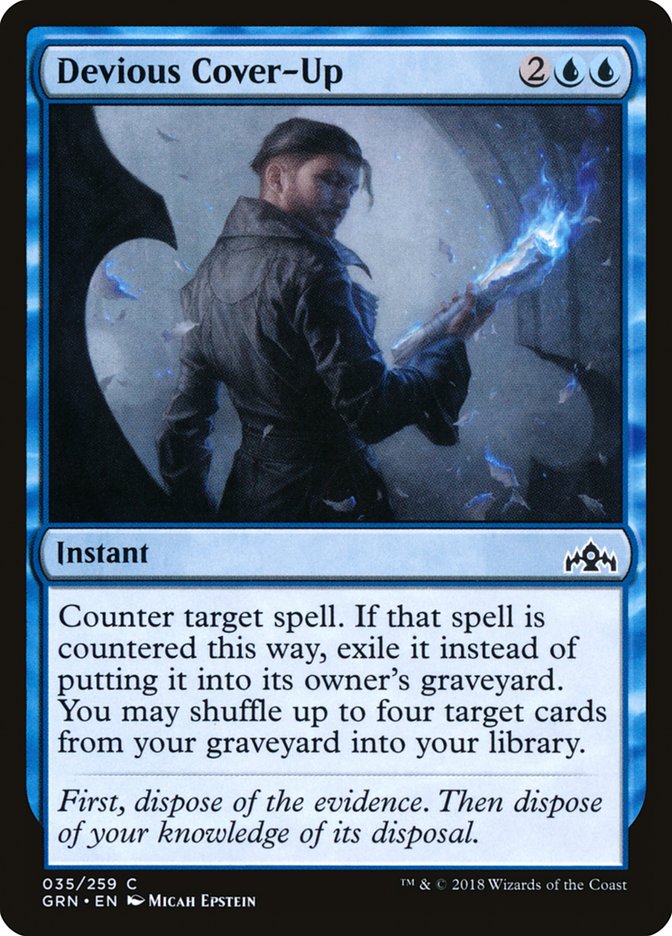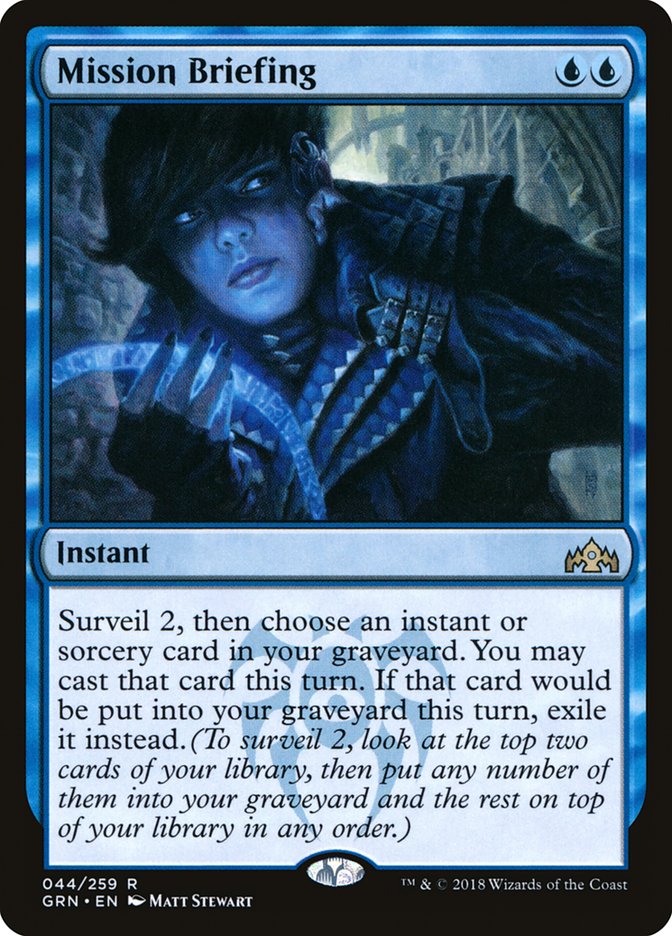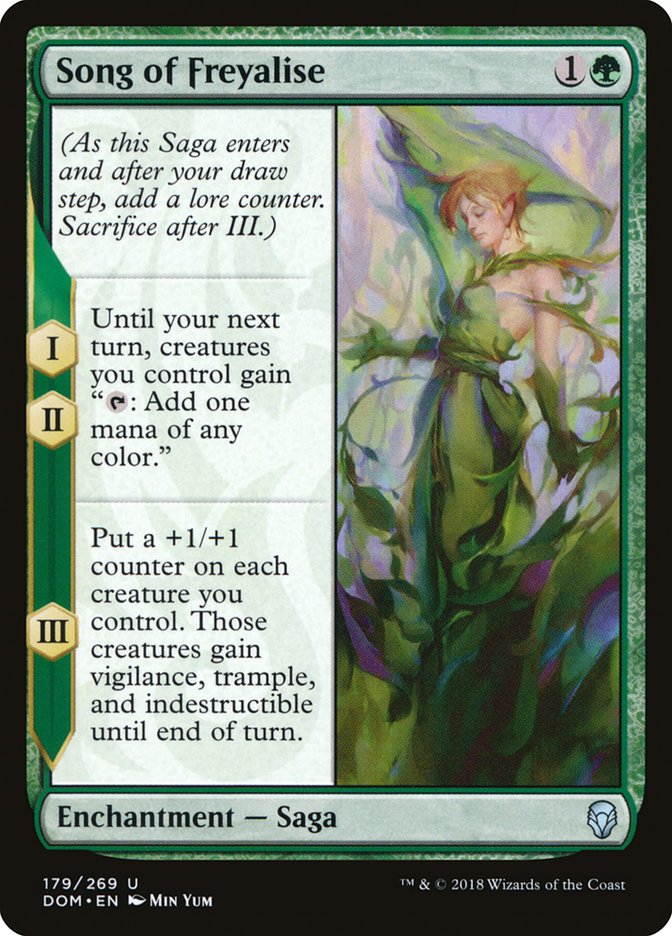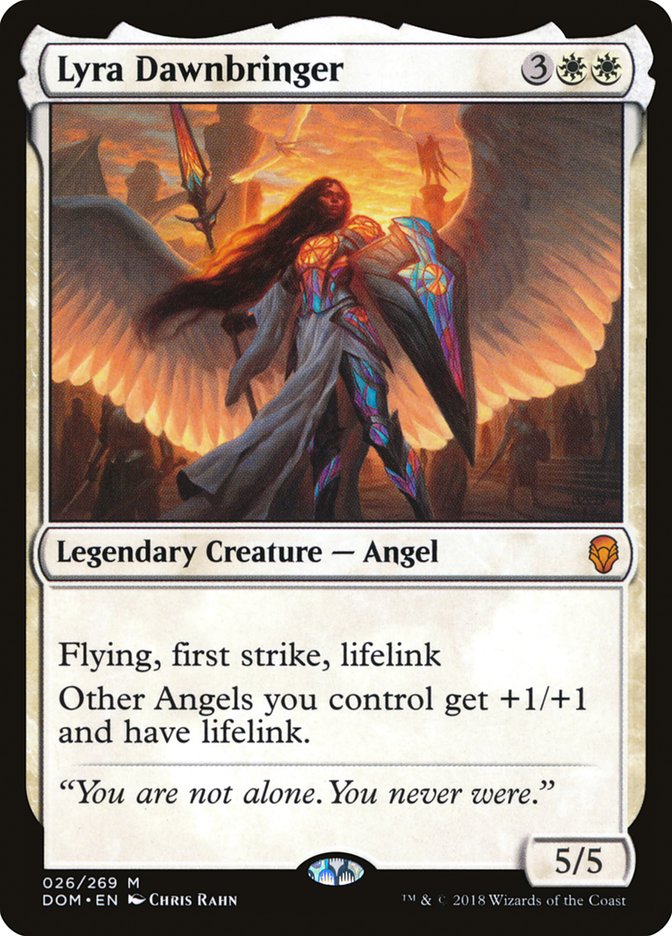Guilds of Ravnica has officially been released and the citizens of Magic Online wasted no time building decks and winning Treasure Chests with Magic’s newest set. I check the Magic Online decklist publications often, and they’re an excellent source of tech for upcoming tournaments. People sometimes refer to the players of Magic Online as the hive mind, and in a way, they are; they’re nameless and faceless Spikes who only care about winning, which shows through in their decklists.
When reviewing the latest decklist dump, the first deck I saw which looked obviously powerful is Mono-Red Aggro. It’s no secret that Goblin Chainwhirler is a sick card and any deck that can give it a home is already inherently advantaged, but Mono-Red Aggro has a new look thanks to Runaway Steam-Kin.
Creatures (20)
- 4 Fanatical Firebrand
- 4 Ghitu Lavarunner
- 4 Goblin Chainwhirler
- 4 Viashino Pyromancer
- 4 Runaway Steam-Kin
Lands (22)
- 22 Mountain
Spells (18)
Sideboard

We’re entering a Standard format which only contains five sets: Ixalan, Rivals of Ixalan, Dominaria, Core Set 2019, and Guilds of Ravnica. This is significant for a few reasons, but the biggest one for me is that the card pool is smaller than usual and thus aggressive strategies benefit the most. Week 1 of Standard, beatdown decks overperform, since the decks you play against are less likely to be tuned or consistent.
Therefore, I highly recommend this updated version of Mono-Red Aggro for a Week 1 metagame. This version has more burn than we’ve seen in the past and I love it. Fanatical Firebrand may look like “just another one-drop,” but if you can reach the final chapter of The Flame of Keld, it’s a walking Lightning Bolt. Viashino Pyromancer behaves similarly.
It’s important to be cognizant of opposing Goblin Chainwhirlers when playing with Runaway Steam-Kin, and I would strongly consider sideboarding it out when on the draw in a red mirror. I can foresee a common play pattern where having The Flame of Keld in your hand will make you feel obligated to cast as many spells as you can as quickly as possible, and if that means putting Runaway Steam-Kin on the battlefield Turn 2 on the draw as a 1/1, you’re taking on a risk, one I don’t feel is acceptable to take, since tournaments are long and it only takes one unfortunate interaction to end your entire weekend.
The first thing I would do to improve this list is move Legion Warboss from the sideboard to the maindeck, where it belongs. It looks like Goblin Rabblemaster to me, and that card terrorized Standard for as long as it was legal. In my eyes, it’s Tier 1 until proven otherwise.
Why will Mono-Red continue to succeed despite its rotation losses? First, this deck has Goblin Chainwhirler and Runaway Steam-Kin, two incredible cards from a power-level standpoint. Second, as noted above, aggressive decks overperform as other decks are being tuned.
The low cost of the cards on Magic Online and short round time mean that if you want to sit around grinding games all day, you get to play more and win a lot without putting too much effort into the games, and some people love doing this.
I’m not trying to discredit the red decks, which are clearly powerful, but what I am saying is metagames self-adjust over time and there are many reasons why the dominance of certain decks may feel overstated at the beginning of a format, Mono-Red being one of them.
For what it’s worth, I wouldn’t underestimate the mana ability of Runaway Steam-Kin either. It hasn’t been long since we had Chandra, Torch of Defiance headlining every red-based deck in Standard, and its +1 ability to produce two red mana was underappreciated at first but quickly became one of the default uses of the card.
With such a low mana curve in Mono-Red Aggro and access to The Flame of Keld, I know exactly where I’d like to spend my extra mana. It’s well within the realm of possibility that you could remove all three counters from Runaway Steam-Kin and get them all back on the same turn or within a single turn cycle.
Planeswalkers (4)
Lands (27)
Spells (29)

Here’s another 5-0 list from CHIRONTHEMAGE and it’s a work of art. I’ve been going deep on Guilds of Ravnica Booster Draft lately. That means I’ve cast my fair share of Devious Cover-Up, and I can safely say it’s awesome. Limited and Constructed certainly are different animals, but I’ve used what I learned from Limited to influence my Constructed deckbuilding for my entire career.
At the end of the day, you’re still playing a game of Magic, and when evaluating a card like Devious Cover-Up, we know replenishing your deck with spells you’ve already used is a tournament-winning strategy, dating all the way back to the first Pro Tour when players used Feldon’s Cane.
With counterspells, the inefficiency is mitigated by the fact that it’s a long-game reactive card. The cost of 2UU versus 1UU on a counterspell isn’t nearly as large as a cost of 1GG or 2GG on something like a 4/4 creature, since the value of a creature lies in how quickly it can deal damage. Curving out is a lower priority for a control deck.
I love Devious Cover-Up because it’s a slightly more effective counterspell than normal, since it exiles the spell you counter with it and it removes all the ugliness of trying to deck the opponent by “tucking” Teferi, Hero of Dominaria with its own -3 ability. Now, you can simply cast Devious Cover-Up, shuffling back your previous copy of Devious Cover-Up and creating a faux Gaea’s Blessing loop.
Magic is a deckbuilding game, and to understand strategy on a deep level, you need to grasp the concept of deck thinning and a term I made up: “deck thickening.” The effect this has on your deck is much greater in Draft, since four cards form a greater percentage of the total cards in your library, but that doesn’t mean the value doesn’t also exist for Standard. I’d also like to emphasize that thickening your deck with four sweet spells from your graveyard isn’t to be underestimated, as every draw spell you take for the rest of the game has an overall increased average value.
Mission Briefing is an unusual card choice. It looks a little weak to me on power level, but the price of UU is cheap and Surveil 2 is also quite strong. Many have said that it looks like a fixed version of Snapcaster Mage, but it’s harder to cast, and although you get some value that’s less powerful than a 2/1 body, it makes good use of a new keyword. Personally, it doesn’t seem worth it to play in Constructed, but I admire the effort to try new cards.
One card that I do love here is Chemister’s Insight. Chemister’s Insight looks like a bad version of Glimmer of Genius, but after having played with it a lot, I look at Chemister’s Insight in the same way I look at Opportunity. When mana is no longer an issue, Chemister’s Insight costs you eight mana and your net is only three cards, but both cards draw four at instant speed and Chemister’s Insight benefits from flexibility.
The cost of the extra mana in games that go long is small, and the loss of a card to Jump-start is also mitigated by the fact that I’m drawing four cards anyway. It will add to the complexity of games, since you’ll want to force the opponent to play a mana-inefficient reactive card on their Chemister’s Insight turn, forcing a Seal Away or Sinister Sabotage. Making plays that result in the opponent wasting mana is the kind of advantage that can add up over the course of a long game.
Creatures (21)
- 1 Tendershoot Dryad
- 4 Skymarcher Aspirant
- 4 Benalish Marshal
- 3 Shanna, Sisay's Legacy
- 2 Shalai, Voice of Plenty
- 4 Yavimaya Sapherd
- 3 Emmara, Soul of the Accord
Lands (24)
Spells (15)

This deck excites me the most, thanks to my love of Song of Freyalise. I’ve played a ton of Dominaria Booster Draft and Song of Freyalise has been a bomb many times. I also have concerns about token decks in a Chainwhirler metagame, but Benalish Marshal thwarts that nicely.
If you’re on the fence about Song of Freyalise, just compare it to Cryptolith Rite, which saw a ton of play in Standard when it was legal. Song doesn’t suffer from the negative effect of drawing multiple copies, since once the final lore counter is added, it’s a superpowered version of Glorious Anthem. When I say “superpowered,” your creatures gain +1/+1, vigilance, trample, and indestructible until end of turn, which means you never have to guess or do math about which creatures to attack with. As long as your opponent can’t cast Settle the Wreckage, you’re in the clear to send in the team.
The metagame will be rich with red decks, and I think Selesnya decks have a good matchup there with careful deckbuilding. I would start by cutting Tendershoot Dryad, which appears simply too bad for competitive play, and replace it with Lyra Dawnbringer. Lyra Dawnbringer is so strong, it regularly shows up in Modern sideboards; you really can’t go wrong putting a card that strong in your deck and the metagame is perfect for it.
The rotation caused red to lose Cut // Ribbons, Soul-Scar Mage, Glorybringer, and Chandra, Torch of Defiance, which all paired well with Goblin Chainwhirler to create a nice five-damage answer to the legendary Angel, but now the red decks are almost totally defenseless. The first decklist I provided has zero cards in Game 1 that can remove Lyra Dawnbringer on a one-for-one basis, and I think that trend will continue.
I’m comfortable with all three of these deck choices as viable Tier 1 strategies, but I do feel Selesnya Tokens is the weakest on paper. Between Mono-Red Aggro and Azorius Control, you either end up with Goblin Chainwhirler or Teferi, Hero of Dominaria in your deck, and you can rest easy knowing you either have the best card in Standard or at least the close second.
I think you can very much be in that conversation with Lyra Dawnbringer and perhaps it’s even best to jam Lyra into the maindeck of either Azorius Control or Selesnya Tokens to increase their power level. Of the two, putting Lyra into the maindeck of Selesnya Tokens is the most compelling because that deck also plays Shalai, Voice of Plenty, another card Mono-Red Aggro cannot kill with only one spell.
Curving Shalai into Lyra makes it so you have two huge lifelink flying creatures and you can make good use of the “secret” ability on Lyra which benefits you for playing an Angel tribal deck or, in this instance, just some sweet value for playing two awesome cards together.
Guilds of Ravnica Standard is new and exciting, but I feel two constants will remain for as long as we play with these cards: decks that contain Goblin Chainwhirler or Teferi, Hero of Dominaria will continue to be the best. It’s possible Teferi decks will play better as three-color decks or potentially even abuse Nexus of Fate, but those two cards are absurdly good and are potential pillars of the format.
Goblin Chainwhirler proved itself as the best card for a midrange shell, so I’m curious if red players will go bigger in an effort to win the mirrors they will inevitably face. Every card you change to make control better against red will cause you to be much worse against other control decks, and the same is true for red.
For SCG Columbus, I would do one of the following:
1. Play Mono-Red Aggro.
2. Put Lyra Dawnbringer in my maindeck.
Neither is overly clever, but sometimes you don’t need to be.



